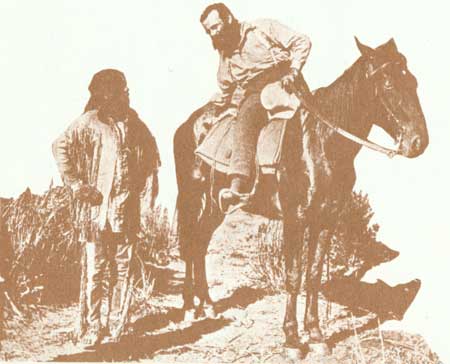
|
Geological Survey Information 74-24
John Wesley Powell: Soldier, Explorer, Scientist |
After the war, Powell accepted a professorship in geology at Illinois Wesleyan University in Bloomington. His method of teaching reflected his training under George Crookham, and he often took his students into the field to collect fossils, minerals, and plants and to observe animals in their natural habitat. The following year he gave a course of lectures at Illinois State University in nearby Normal, Illinois. The State Legislature provided a small endowment for the museum of the State Natural History Society, and Powell was named curator.

|
| A scene of Powell's teaching career. Illinois Wesleyan's first building, 1856. |

|
| John Wesley Powell, winter 1869. |
Powell loved to travel; it had been one of his main interests before the war. In 1867, he led a party of students to the Rocky Mountains to collect specimens for the museum. Funds for the trip came from various sources, including the Museum of Natural History—$500, the Illinois Industrial University (later the University of Illinois)—$500, and the Chicago Academy of Science—$100. In return he agreed to supply them with specimens of the animals, plants, and any other materials collected. Scientific instruments were loaned by the Smithsonian Institution, and Powell agreed to give the Institution the topographic measurements made by his party. He made arrangements to procure rations for the group from Army posts at Government rates and to obtain free transportation from the railroads. Powell contributed his own salary to help finance the trip.
In May and June of 1867, the expedition, which included Mrs. Powell, traveled by train, wagon, and horseback across the plains to Denver and on to a valley known as Bergen's Park on the west side of the Rampart Range north of Pikes Peak. After climbing Pikes Peak they traveled west to South Park where they camped for several weeks, exploring the mountains and hot springs and making a variety of natural history collections.
Most of the group returned east in September, but the Powells and a few others remained to explore Middle Park and the headwaters of the Grand River, as the upper part of the Colorado River was then called.
In the summer of 1868, Powell returned to Colorado with his wife and about 20 others, mainly neighbors and students. They collected more specimens for the museum, explored the Colorado mountains, and climbed 14,000 - foot - high Longs Peak.

|
| Student members of Powell's 1868 expedition. |
In October, the party reached a point on the White River about 120 miles above its mouth where they built cabins and established winter quarters. During the winter of 1868-69, Powell traveled south to the Grand River, down the White and Green Rivers, north to the Yampa River, and around the Uinta Mountains. He befriended a tribe of Ute Indians and studied their language and customs. His interest in the Indians of the West grew, and in 1873, as a special commissioner to the Indians in Utah and eastern Nevada, he pleaded for greater justice and more educational opportunities for the Indians.

|
| Ruins of an ancient Indian settlement on the rim of the Grand Canyon. |

|

|
| Navajo boy. | Tau-gu, a chief of the Paiute Indian tribe and Major Powell in southern Utah. |
By 1868, Powell was considering exploration of the Colorado River, undeterred by legends of earlier expeditions that had perished. Lieutenant Joseph C. Ives, who in 1857 explored the southern stretches of the river below the Grand Canyon, believed "that the Colorado, along the greater part of its lonely and majestic way, shall be forever unvisited and undisturbed." But after studying the few reports, talking with Indians, hunters, and mountain men familiar with the area, and exploring tributary streams similar to the Colorado, Powell decided it was possible to explore the river by descending it in small boats. He obtained some funds from private sources and from the Illinois State Natural History Society, and he gained permission from the Government to requisition military stores. He had four boats built in Chicago to his own design and specifications and had them shipped to the proposed starting point at Green River Station, Wyoming Territory. He selected a crew of nine who, with the exception of his brother Walter, were mountain men experienced in living off the land. On May 24, 1869, Powell launched his boats on their historic journey.

|
| Major Powell talking to a Paiute Indian during northern Arizona survey. |
| <<< Previous | <<< Cover >>> | Next >>> |
inf/74-24/sec2.htm
Last Updated: 28-Mar-2006